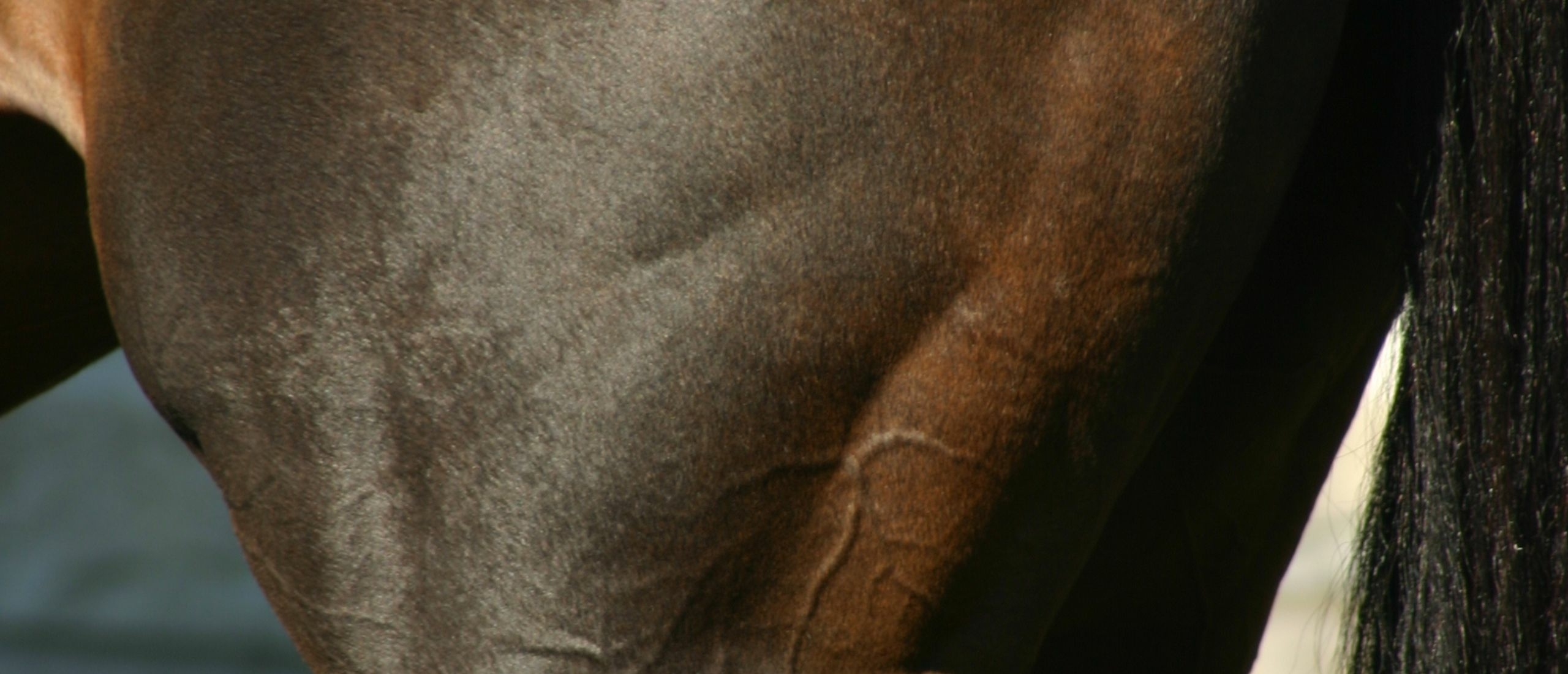
Muscles of the horse
When doing Straightness Training (ST) we strive for keeping our horse in between our aids, and when working on the ground, it means in between our rein and whip aids. This way we can influence and shape the whole body of the horse, not only the head and neck.
Now to get a horse in between your rein and whip aids, just imagine a whip in between your hands: this way you can round the whip. It’s the same with an arrow in a bow: because of the arrow, the bow will bend and get round. To transfer this idea to horse training, the horse has to use his skeletal muscles in a special way to maintain this round posture.
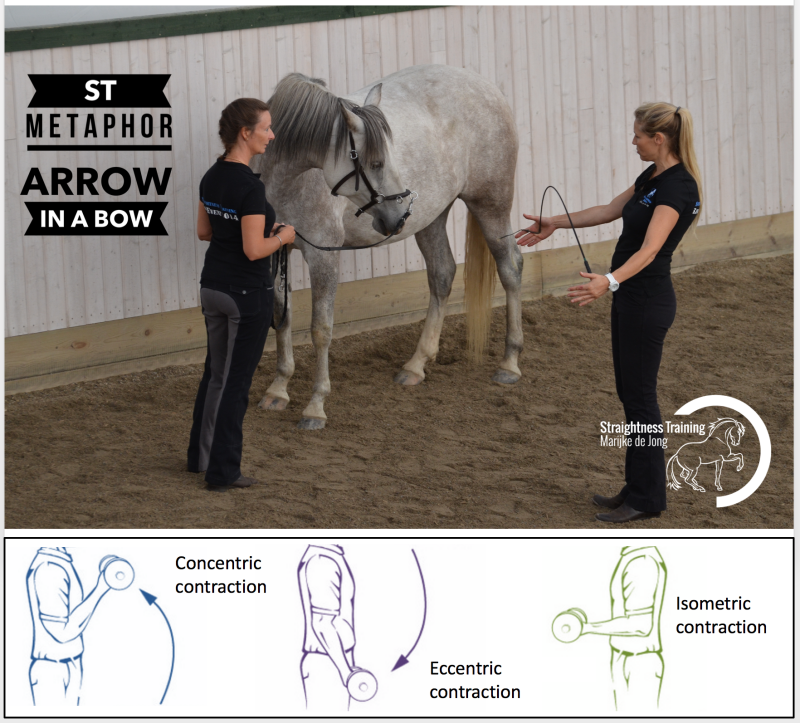
Map of the territory
Since there are approximately 700 skeletal muscles in the horse, which produce movement, create stability and maintain the posture, it’s quite a complex territory to dive into. Especially if you also would like to include tendons, ligaments, fascia, nerves, hormones and many, many other elements that are necessary to create movement, stability and posture.
But in order to explain the ‘arrow in a bow’ metaphor, let’s make a small ‘map of the territory’, so here we go:
- Skeletal muscles work in pairs, groups or chains to create movement, by one contracting as the opposite one relaxes.
- A single contracting muscle is known as an agonist and the relaxed or stretched muscle is known as the antagonist.
- Although contraction implies shortening, when referring to muscles, it means the generation of tension within a muscle fiber, therefore a contracting muscle may lengthen, shorten or remain the same. So there are three types of muscle contractions, all defined by the changes in the length of the muscle during contraction.
Three types of muscle contrations
Knowing the difference between the three types of muscle contractions is important when it comes to understanding of the ‘arrow in a bow’ and ‘tomato shape’ metaphors:
► 1. Muscles can contract and shorten – called concentric muscle activity: This is related to movement and it creates force, which is for example necessary if a human wants to lift weight (see the blue person on the picture: a concentric contraction of the biceps cause the arm to bend). A horse example is bending the hind legs in piaffe by shifting the horse’s weight more back.
► 2. Muscles can contract and lengthen – called eccentric muscle activity: This is related to movement and it happens for example in the controlled lowering of the heavy weight (see the purple person: an eccentric contraction of the biceps). A horse example is making a balanced halt after doing piaffe, where the muscles in the hind legs will elongate while the muscles are still generating force.
► 3. Muscles can contract without changing the length of the muscle – called isometric muscle activity: This is related to maintaining posture and it creates force which is for example required to grip but not move a heavy object (see the green person, holding the weight, but not moving it). In the photo I am also using isometric contraction by holding the whip in a steady position. A horse example is doing the levade, where the horse has to hold a posture for 2 seconds, carrying all his weight 100% on the hind legs. Horses also use this type of muscle contraction during transport in order not to fall. And…. isometric contraction is also used to maintain the ‘tomato shape’!
So here we are back at our metaphors!
Isometric contraction
In movement a horse uses all three types of muscle contraction, but it’s this isometric muscle activity that plays a huge role in the ‘the ‘arrow in a bow’ concept.
In this concept you keep your horse in between our aids, you use ‘the wind in the sails’ – starting the energy in behind, canalizing it in front – ending up with a round ‘tomato shape’ .
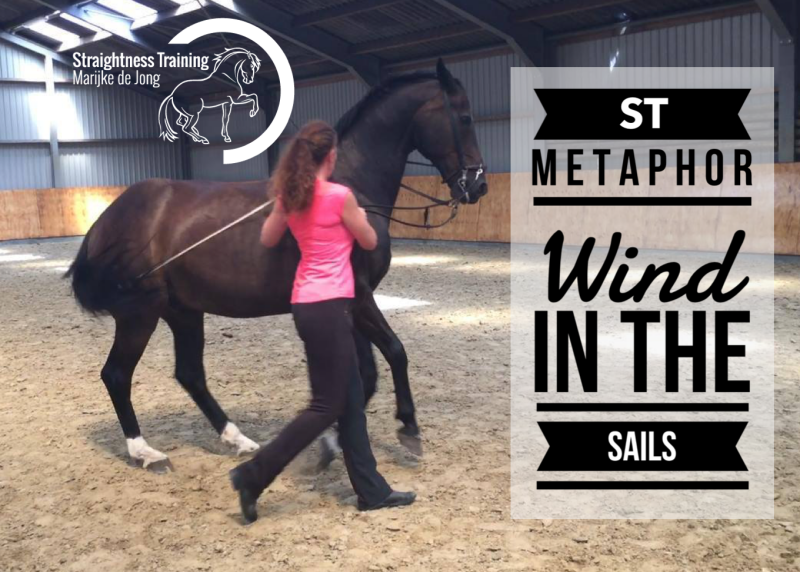
When doing ST with a horse you want to strive for the feeling of ‘sailing’:
First you want a nice ‘wind’ blowing from behind, this is the energy you generate from engaging the hind legs to step forward and under the center of mass so they can carry.
This ‘wind’ needs to blow forward over his back, through his spine, into the contact of the reins which are your ‘sails’.
Now if there is no ‘wind’ then your sails will be limp and lifeless with nothing to shape or direct. If there is ‘wind’, but your ‘sails’ are not connected, then they will blow forward and out, unable to catch and shape the ‘wind’ energy.
So you need the wind AND to have trimmed the sails properly. You do so with a combination of aids: your inner picture, inner feeling, energy, body language, whip and reins: You start with influencing the hind legs and then you catch and canalize the energy in front with your reins. The moment your horse gives you the round, connected shape, you release in order to encourage self-carriage in the horse’s body and mind.
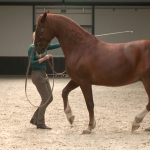
In this round, connected posture, the horse uses isometric muscle activity in the area of head and neck so his nose doesn’t get in front of the vertical. During the work, the muscle length doesn’t change, because when it does, when the isometric contraction disappears, the horse ends up in a long ‘cucumber shape’, poking the nose far in front of the vertical.
And not only in the area of head and neck you encourage this isometric muscle activity, but you strive for the so called ‘self-carriage’ in the whole body, and this requires a lot of core strength and core stability.
Self-carriage
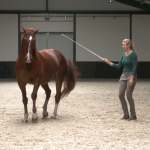 In isometric muscle activity even the smallest stabilizing muscles will be trained, because these deep muscles are needed to get a secure and steady balance, so this isometric muscle contraction can be very tiring in the beginning: imagine, you have to hold that dumbbell for 5 minutes in the same, steady position!
In isometric muscle activity even the smallest stabilizing muscles will be trained, because these deep muscles are needed to get a secure and steady balance, so this isometric muscle contraction can be very tiring in the beginning: imagine, you have to hold that dumbbell for 5 minutes in the same, steady position!
But over time, the horse will get stronger and balanced and the more self-carriage a horse has, the less we have to help the horse to stay in a round, connected energy and frame, and then he will also be able to give the powerful posture and self-carriage in ST at liberty.
Development of connection
Creating self-carriage is not a ‘quick fix’, it doesn’t happen overnight. Imagine you going to the gym where you start to lift weights. In the beginning you will train with light weights so you can focus mainly on the technique in order to create precise movement and posture, so you won’t ruin your back once you start to lift more heavy weights.
So at the start of the ST education, we mainly focus on stretching short, stiff muscles, because stiff muscles will affect the movement and posture. But only loosening the muscles won’t help the horse, because stiffness provides in a way some core stability, and when you remove all stiffness and there’s no other muscle activity, the horse will move like a drunken sailor.
So while suppling the stiff muscles we also encourage long, weak muscles to contract. Plus we focus on developing the LFS, where the horse learns to stretch his body to both sides (Lateral bend), starts to stretch his topline (Forward down) and starts to use his hind legs to support his body (Stepping under), so his balance and coordination improve.
 Once the horse is more supple, balanced and coordinated in body and limbs, we start to work on the isometric muscle activity: we make a start with developing the connected ‘tomato shape’ by using ‘the wind in the sails’ and the ‘arrow in a bow’ concepts.
Once the horse is more supple, balanced and coordinated in body and limbs, we start to work on the isometric muscle activity: we make a start with developing the connected ‘tomato shape’ by using ‘the wind in the sails’ and the ‘arrow in a bow’ concepts.
At the start, we help the horse to stay round and connected, and just to be clear, it’s not about ‘forcing’ the horse into the shape, because then the horse will become very short in the neck, or the nose will get too much behind the vertical, or the horse starts to resist and stiffen. To compare it to a branch of a tree, a twig, when you use too much force on both sides, it will break. So we avoid to be rigid and instead, with our inner picture, inner feeling, energy, body language and whip and rein aids we act as a kind of elastic band around the horse’s body that causes a bit resistance to the horse’s muscles and we ask the horse to yield to stay in shape. After the yielding you encourage the horse to searches towards the hand, keeping a long, arched neck. And this connection sets the horse up for collection.
Multidimensional muscle training
Horse training is very multidimensional: You want to stretch and relax stiff muscles, but you also want to contract supple muscles in three different ways, while he’s shortening, lengthening and holding his muscles.
By keeping our horse in between our aids, we boost the training effect, because it allows concentric, eccentric and isometric multidimensional muscle training.
So overall, doing ST will improve the horse’s flexibility, coordination, core stability and core strength, so it helps the horse to gain mobility and to develop self-carriage.
And to give the ‘arrow in a bow’ metaphor a second dimension:
A horse who works in nice self-carriage, builds inner power – especially in trot and canter – so when you release that power, the horse will take off like the arrow in that bow: he will go very fast forward! Like the cork on champagne. That’s why you need to do collection with lazy horses, rather than driving them forward: connection and collection will lead to horses that go forward like an arrow in a bow . If not, if they collapse as soft pudding after you take away the frame, you have to change your approach a bit in your lab…. hmmm…. something to think about….

